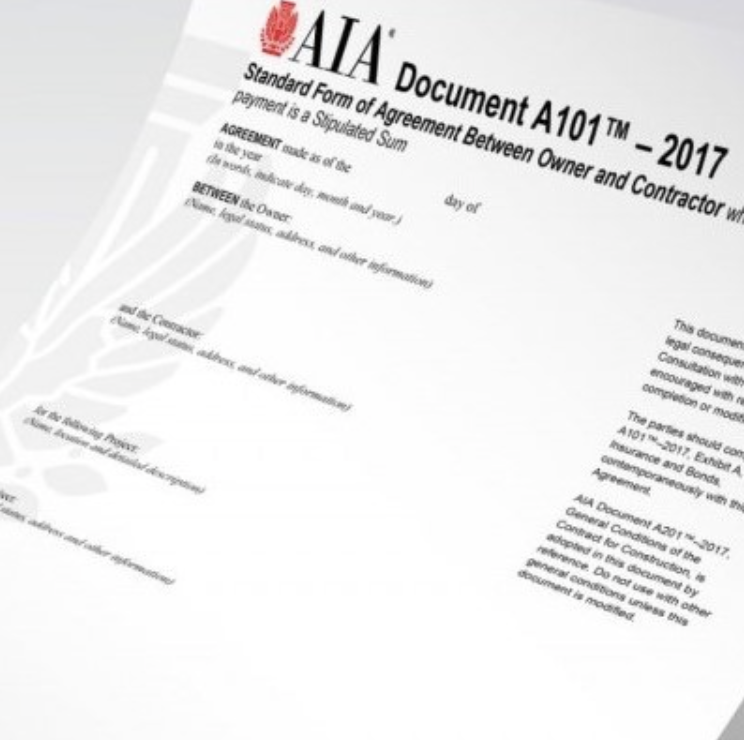By Christopher D. Ling | May 2024

(Image courtesy of AIA.)
Introduction
In my career both as a design architect and a seasoned forensic architect, I have worked on over a thousand construction projects, each with its unique complexities and challenges. A key examination technique is to compare and contrast a projects contract to the American Institute of Architects (AIA) form contracts.
Attorneys, owners, contractors and architects often rely on AIA form contracts to set a solid base for risk and reward allocations. These standardized legal documents serve as a crucial foundation for the Owner-Architect-Contractor relationship and the construction project as a whole. In this essay, we will explore the reasons why architects use AIA form contracts and the advantages they offer in navigating the intricate world of construction.
Defining AIA Form Contracts
The American Institute of Architects has been at the forefront of promoting professionalism and standardization within the architectural industry. Among their many contributions, AIA provides a comprehensive library of form contracts curated specifically for the construction industry.
These AIA form contracts are pre-written legal agreements that establish the terms, rights, and obligations between all parties in a variety of project delivery options. They provide a consistent framework for various aspects of the architectural project, including scope of work, compensation, timelines, responsibilities, dispute resolution, and more. While AIA form contracts are to be edited, adapted and customized to the project, they offer a standardized starting point for all construction agreements.
Clarity and Consistency
One of the primary reasons architects choose to use AIA form contracts is to ensure clarity and consistency in their agreements. These contracts have been developed, reviewed, and refined by legal experts, industry associations, and professional organizations, with the AIA at the forefront. They are designed to cover a wide range of scenarios and potential issues that can arise during a construction project.
By utilizing AIA form contracts, architects can be confident that they are working with a document that is well-vetted, comprehensive, legally tested and current with industry standards. This consistency in language and structure provides a clear and unified understanding of the project’s terms, minimizing the potential for misunderstandings and disputes.
Efficiency and Time-Saving
Customizing contracts from scratch can be a time-consuming and costly process. Architects often have tight project schedules and need to allocate their time and resources efficiently. AIA form contracts help streamline the contract creation process by offering a ready-made framework that can be adapted to specific project needs.
This efficiency is particularly valuable for architects who may work on multiple projects concurrently or have recurring clients. They can quickly modify the standard AIA contract to address the unique requirements of each project, saving time and ensuring that critical legal terms are not overlooked.
Risk Management
Construction projects inherently carry risks, and architects must manage these risks to protect the interests of all parties. AIA form contracts are designed with risk management in mind. They include clauses that address issues such as project delays, scope changes, insurance, warranties, dispute resolution, and more.
By using AIA form contracts, architects can establish clear risk allocation and defined responsibilities. These contracts help define who is responsible for what, what remedies are available in case of disputes, and how potential issues will be resolved. This structured approach to risk management provides a level of security and predictability for all parties involved.
Legal Protection
Architects often work with legal advisors who specialize in construction law. AIA form contracts are well-recognized and widely accepted within the legal community, especially in the context of construction and architecture. This cognizance can be advantageous in case of disputes or legal actions.
In the event of a disagreement, having an AIA contract that is based on established legal principles can facilitate the resolution process. Courts are familiar with the language and structure of AIA form contracts, making it easier to interpret and enforce the terms of the agreement.
Client Expectations and Industry Standards
Many clients, particularly those with experience in construction, expect to work with architects who use industry-standard AIA form contracts. These clients may be familiar with the terms and clauses commonly found in these contracts, which can help expedite the negotiation and agreement process.
AIA form contracts align with industry standards and best practices, demonstrating the architect’s commitment to professionalism and adherence to recognized guidelines. This can build trust and confidence between the architect and the client, which is a bedrock for a successful project.
Conclusion: A Structured Path to Success
In the complex world of architecture and construction, AIA form contracts serve as a structured path to project success. All stakeholders benefit from the clarity, efficiency, risk management, legal protection, and alignment with industry standards that AIA form contracts provide. While they may require some customization to address specific project needs, these form contracts offer a strong foundation for owner-architect-contractor agreements, helping to foster mutual understanding and productive collaborations. Ultimately, AIA form contracts, with their trusted and established framework, contribute to the successful realization of architectural visions while safeguarding the interests of all parties involved.
Christopher D. Ling, AIA, NCARB, PP, LEED AP, is a seasoned construction expert with over three decades of experience. As a Registered Architect and Professional Planner, he has authored reports for 1000+ construction cases, totaling $2 billion. Founder of ARCHforensic® LLC, Ling specializes in resolving litigation claims through meticulous investigation and expert testimony.







